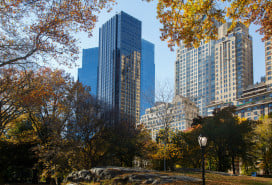13 staging mistakes that can cost you the sale of your co-op or condo
- Skipping a fresh coat of paint and window treatments are common oversights
- Having too many personal items is another no-no, as is a giant TV on the wall
- Many stagers offer packages in a range of budgets—or you can do it yourself

A NYC living room staged by Urban Staging with plants, furniture, wall decor, and curtains.
Photo courtesy Urban Staging
First impressions are everything when it comes to selling your New York City condo or co-op.
Apartment buyers are likely to visit both new condos and resales. So if you’re selling, your goal is to style your place to compete with a brand-new apartment when a buyer comes to your door—or scrolls through your unit’s listing photos.
Brokers and stagers often rely on professional photographers to capture all the right angles and lighting to secure a sale. After all, they are up against NYC condo developers who have the money to create pristine model apartments.
“You cannot afford to let a resale apartment come across as a dud," said Michael J. Franco, a broker at Compass.
That’s why it’s important to present a property in a way that allows buyers to see its full potential. You can use staging as “makeup” to enhance its beauty and disguise its flaws, said Daniela Schneider, founder of the staging company Quadra.
[Editor’s note: An earlier version of this post was published in August 2024. We are presenting it again with updated information for September 2025.]
Whether you hire a staging pro or decide to do it yourself, you’ll want to avoid a few routine mistakes.
1. Not painting the space
One of the most common oversights is not painting your space, Schneider said. Stick with one of the countless shades of white to keep your apartment looking clean, fresh, and bright. Buyers have been bombarded with images of pristine, unlived-in condos, so you’ll need to compete with that fantasy in their heads.
And as a seller, you’re also up against the “HGTV effect,” where buyers have been conditioned to expect move-in ready, picture-perfect apartments—with no work required at all. A fresh coat of paint gives you a shortcut to achieving that reality-show look, though it can cost upwards of $1,000, depending on the size of your unit.
“You can even freshen up tired kitchen cabinetry with a coat of paint,” Franco said.
If repainting isn’t possible, it’s more important than ever to simplify the space through other means, especially by decluttering, said Dawn Trachtenberg, owner of the staging company Staged Ryte. (Get ready to unleash your inner Marie Kondo).
“It really depends on the price point and demographic, but most often, less is more,” she said.
As an added incentive, some brokerages offer no-fee renovation loans to make it easier for you to paint or make upgrades to your place that you don’t have to repay until you close.
2. Installing curtains badly—or not at all
Forgoing window treatments is another common mistake, said Schneider. In her experience, people who skimp on curtains will overcrowd an apartment with expensive furniture to make the space feel less empty and cold.
“Oftentimes, you are hiding ugly window frames that impact the feeling of the room so much," Schneider said.
Stick with neutral curtains, or an oatmeal or "greige" tone if your walls are white to create a touch of color to create contrast. Most stagers will work with the curtains you have, but if your window treatments are in a bright-colored floral print, that will be the only pattern allowed.
Another curtain faux pas to avoid: If you hang curtains right above the windows, rather than placing the curtain rod near the ceiling, the unit will feel smaller.
“You want the curtains as high as possible to change the sense of height and space—especially in a small footprint,” Schneider said.
If your apartment gets little to no natural light, some agents opt for sheer curtains or ditch them altogether to let as much light in as possible.
3. Underestimating lighting fixtures
Along with the paint and the curtains, lighting is an important aspect of staging. “Light fixtures are the jewelry of the space,” Schneider said.
If you lack natural light, you’ll want to brighten your space with additional lighting, mirrors, or other reflective surfaces. You can swap out harsh, cool-temperature LEDs for warm bulbs. Or, use lighting strategically to create intimacy in a larger room and to spotlight artwork or another focal point for that “wow” factor.
Schneider occasionally works with a seller’s light fixtures, but said she often likes to install her own.
“It really has to be the right fixture, because it brings so much personality—it informs the feeling of the space,” she said.
If you're unsure how your apartment will come across to prospective buyers, how much time and money you should invest in staging or renovating, or if you simply want to test the waters, consider "pre-marketing" your co-op, condo or brownstone before you publicly list it. The pre-marketing platform at New York City brokerage The Agency is a no-risk way to quietly test your asking price and marketing strategy among actual buyers shopping for a place like yours. There's no charge to participate and no obligation to sell or enter a traditional listing agreement if you haven't found a buyer by the end of the pre-marketing period. To learn more, click here. >>
4. Leaving personal items on display
Personal items can make it more difficult for a potential buyer to establish an emotional connection with your apartment, thereby making your apartment harder to sell.
Even if you’re staying in your apartment until it sells, Schneider recommends that you “de-personalize” your unit as much as possible.
“You have to create the canvas for the next buyer,” Schneider said. “They have to be able to envision themselves in the space."
So whether it’s your Funko Pop collection or assortment of blown-glass objects, Trachtenberg said it’s time to pare back.
“Making it special and curated is really key,” she said. “It’s ok to have that collection but maybe not all 50 pieces.”
Ultimately, you have to walk a fine line between creating a connection and alienating buyers with anything too specific. New York’s buyer pool is one of the most diverse in the world. Buyers won’t want to see evidence of your political or religious leanings—and that goes for your holiday decorations as well.
Practically, some items may just have to stay put, such as large furniture that you might not be willing to put in storage. A designer might be able to work with your dining table, buffet, or credenza but be less happy about you keeping your novelty couch. Some brokers may even have a few pieces they let clients borrow for staging if you’re in need of more palatable knick knacks.
5. Going too wild with patterns
You should absolutely ditch your mismatched furniture—and your recliner, Trachtenberg said.
“Having too many sofas and too many patterns going on—it’s very confusing,” she said. “Don’t have two different floral sofas or a striped sofa and a patterned chair.” Your recliner “might be comfortable, but it’s not a good look.”
Schneider recommends adding colors “very minimally,” and using greenery from indoor plants or maybe a yellow or blue throw. But avoid red or orange palettes. Those shades give off a nervous active energy, and you want people to feel calm and encourage them to linger in the apartment, Schneider said.
Trachtenberg is less averse to colors but insists what might be right in one apartment is definitely wrong in another. She will incorporate color in pieces of furniture or with throw pillows.
“It might be a turquoise chair with a neutral sofa, or a neutral sofa with blue pillows on it, and then picking up some blues in some of the accessories or books on the cocktail table so it doesn’t look bland and gray,” she said.
Even Schneider sometimes breaks her own rules on color: Quadra worked with the owner of an apartment at 254 Park Ave. who didn’t want to paint or install light fixtures. The apartment had very high ceilings and dark flooring.
“We did the whole apartment in black and white and then put two very modernist, beautiful red velvet chairs there,” Schneider said.
6. Being boring and cookie-cutter
Buyers are scouring listings, and the same staged aesthetic—the beige couch, the cream rug—can start to look very tired. To make yours stand out from the crowd, do your homework.
Find out what else is for sale in the same building or in the same neighborhood. You can partner with your broker, who will know the comps and be strategic in your staging so you can target your ideal demographic of buyer. For example, you wouldn’t stage a renovated loft in Tribeca the same as a prewar apartment on the Upper East Side.
That’s where Trachtenberg says pops of color can help.
“Our feeling is people need to be able to picture themselves in the apartment, and not everyone lives in that sterile cookie-cutter fashion," Trachtenberg said.
Don’t be afraid to take calculated design risks, like hanging eye-catching artwork and even mixing it up with canvas, photographs, and other items. That might also include a chalkboard panel in a kid’s room or wallpaper in a living room. Just beware of potentially off-putting artwork. Not everyone may appreciate that graphic nude or explicit graffiti (and kids are likely to come across it, too).
In the end, it’s all about striking a balance and making your apartment more inviting and exciting than the others.
7. Ignoring clutter
If ever there was a time to declutter, it’s before you sell your apartment. Once your property is on the market, you have to think of it as a product, not a home. That means turning it into a lifelike, albeit idealized state.
Storage, or the lack thereof, is a definite deal breaker. Leave your closets at least 30 percent empty to let some air between items. (Overstuffed closets won’t help a sale.) Put all but in-season clothes and outerwear in a storage unit. Don't leave stuff on the floor—use canvas and woven bins to hide your belongings.
Your closet is sending would-be-buyers a message: If you lived here, “your life would be as organized as this closet,” one organizer told Brick Underground. Some even go as far as to treat the closet as if it were a little room, with wallpaper and an attractive light fixture. For more tips, read “Staging your closet when selling your NYC apartment."
8. Letting the TV dominate the room
Buyers want to see where their TV will go—but leaving your 52-inch flat screen hanging on the living room wall is a mistake.
“It’s ugly, it’s cold, it tells buyers you are going to have to be watching TV where you also want to entertain,” Schneider said.
Even worse is when the TV is old, clunky, and "says you haven't changed things out in way too long,” making the rest of the space feel dated, Trachtenberg said.
You want the living room to be as pretty, inviting, warm, and beautiful as possible. A TV has none of those qualities, Schneider said. It also doesn't photograph well, so take the TV down before snapping any listing images.
If you don’t want to give up your shows while you sell, you could incorporate your TV into the staging.
“Surround the TV with black-and-white framed prints, so it becomes one of the prints or part of a gallery wall,” Schneider said. (That may be why you see so much black-and-white wall art in listing photos.)
Another workaround: Schneider will ask the broker to play a vintage movie during an open house—more black and white.
“Something that won’t offend anyone and won’t interfere with the colors of the space," Schneider said.
And if you simply must keep the TV on the wall, "at least pare down whatever else is around it to keep the space from looking too cluttered,” Trachtenberg said.
9. Not adding a home office
If you don’t have a dedicated home office, you’ll still want to show where a buyer could put a desk—especially now that working from home is the norm. Being able to show potential buyers where that workspace can exist is crucial, Schneider said.
Schneider suggests using the primary bedroom in an apartment without a nook or dedicated workspace.
“You can put a desk by the window facing out with a beautiful chair and the best lamp—it’s going to actually look pretty and functional," she said.
Other options might include under a staircase, inside a closet, or in the foyer or hallway by parking a slim-profile console there.
10. Blocking your sightlines
Many NYC apartments have open floor plans, where your kitchen, living, and dining areas all flow into each other. But that can make it difficult for a buyer to visualize how much space there is and whether it meets their needs.
You can often use furniture—such as rugs—to delineate areas and control the flow. However, you want to avoid crowding the layout with lots of heavy pieces or blocking the sightlines from one room to the next. In other words, avoid turning your formerly laid-back den into a (stuffy) dining room that seats 10.
On a related note, put a bed in every bedroom, even if it’s a daybed. People can always envision a home office, but they might need convincing that a space can really work as a bedroom.
11. Crowding your space with furniture
You won’t convince a buyer your apartment is bright and airy if you stuff it full with oversized furniture.
Large pieces can emphasize a unit’s awkward layout—like a long and narrow living area. Instead, opt for smaller, sleeker furniture, even in prewar apartments.
If you’re trying to convince a buyer your apartment is bright and airy, but you fill the place with oversized furniture that eats up all the space—your message won’t get through. Franco said buyers don’t typically want to see traditional furnishings these days.
You should also avoid dark wood furniture and tiny rugs that make a room look small. Trachtenberg said even stagers are guilty of sometimes putting in rugs that are way too small for a room; a larger rug that goes under a couch feels more luxurious and space-expanding.
“You really want the furniture to be on the rug and not have the rug stop in front of the sofa or only have it under the coffee table,” she said.
12. Making your place too austere
You want your space to feel clean, but not cold. A few fur throws and pillows in the right place can be sumptuous.
You might even put cushy terry robes and some slippers in a closet. And consider adding crisp white bedding and fresh flowers in the bedroom, towels, and new soap in the bathroom. While these touches can look luxurious, try to avoid making your sleeping quarters look too contrived. Less is always more.
13. Foregoing staging entirely
Staging appeals to a lot of sellers, but often they balk at having to pay for it.
Staging fees start around $5,000 for a studio, and can go up to $25,000 for apartments with more than three bedrooms. If that sounds like too much, there are affordable ways to work with a staging expert. Perhaps you just need a professional eye to come and help rearrange and edit what you already have, or give just one or two rooms a thorough redo.
Lots of stagers offer a range of packages to accommodate most budgets, and your broker can help if you’re short on funds; Franco has a specialist do the heavy lifting of decluttering.
But decluttering doesn’t mean ditching everything. Empty apartments don’t sell. They seem too small and lack personality.
Case in point: When it came down to choosing between two apartments in the same building, one of Franco’s clients went with the staged one, despite having a less desirable northern exposure, instead of the empty one facing south. Brokers and stagers have plenty of tales like this.
Previous versions of this post contained reporting and writing by Marjorie Cohen, Evelyn Battaglia, and Emily Myers.
You Might Also Like




























